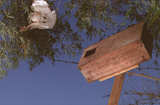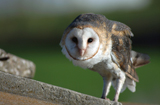Barn Owls
Barn owls (Tyto alba) are easy to recognize because of their pale round faces and shrieking call. They also are welcome predators that control rodent and other small mammal populations.
Identification, Habitat, & Behavior
Identification
You can identify barn owls by their distinct heart-shaped white face and lack of ear tufts seen on other owl species. Other characteristics include a white or tan underside with spotting; long wings that are brown, black, and white shaded; and long legs you can see when they are roosting or flying overhead.
Habitat & Nesting
Barn owls like to nest in open areas. You can find them near agricultural fields, grasslands, and marshes. They will nest in hollow trees or buildings, as well as nesting boxes.
Barn owls are monogamous, and pairs will stay partnered for several breeding seasons. In Florida, they will usually lay their eggs in February. In South Florida, barn owls will produce a second set of offspring in the late summer or fall.
Barn owls lay an average of between four and six eggs. An owl will lay each egg two to three days apart, and the eggs will hatch in that same order. Each chick will have an age difference of a few days. This is a survival mechanism that ensures a few chicks will survive if food becomes scarce.
Hunting
Barn owls spend their days resting ("roosting") in quiet areas and spend their nights searching for food. These nocturnal hunters mainly catch small mammals such as mice, voles, rats, muskrats, and marsh rabbits. They will also occasionally catch and eat lizards, amphibians, and other birds.
Barn owls usually swallow their prey whole. They regurgitate the bones and fur they cannot digest in the form of an "owl pellet." Sifting through pellets, you can get an idea of the animals in the barn owl's diet.
Nesting Boxes
As their name suggests, barn owls typically like to nest in man-made structures, such as barns, silos, sheds, and church steeples.
Their nests are messy places, littered with remains of their prey and excrement pellets. Building a nesting box lets you encourage barn owls on your property without having to deal with their mess in inconvenient places.
Materials
- One 4' x 4' sheet of 5/8" exterior plywood
- One 1" x 12" pine board, 6' in length
- One 4" x 4" pressure-treated post, 16' in length
- One box of #6 1-5/8" galvanized screws
Panels and Construction
Cut the front, back, and top of the box from the sheet of plywood:
- Two 38" x 17-1/2" pieces (front and back)
- One 38" x 12-1/2" piece (top)
You will have leftover plywood.
On the front panel, cut a 6" wide x 7" high entrance hole that is 2" away from the left hand side of the panel and 7" from the bottom.
Cut the side panels and bottom from the pine board:
- One 11-1/4" x 38" piece (base)
- Two 11-1/4" x 16-3/4" pieces (ends)
Drill a minimum of 10 drainage holes in the pine-board base piece.
Arrange and screw together the plywood top, front, and back pieces and pine-board ends and base together to form a box with a dimension of 38" width, 18" height, and 12-1/2" depth.
Installing
 Attach the box to the post and put the nesting box in an open field or on the edge of an open area. This way the owls can glide freely in and out of the box. Position the box so that the entrance faces north in order to keep sunlight out.
Attach the box to the post and put the nesting box in an open field or on the edge of an open area. This way the owls can glide freely in and out of the box. Position the box so that the entrance faces north in order to keep sunlight out.
You can also choose to install the nesting box without the post and mount the box on shed rafters, barn walls, or in silos.
The owls nest on top of the debris, pellets, and feathers in the nesting box. These materials help insulate incubating eggs. If too much material accumulates inside the nesting box, the owls will push it out—there is no need for you to clean out nesting boxes.
More Information
For more information about barn owls, you can visit the Everglades Research and Education Center's page on their barn owl research or contact your local Extension agent.
Adapted and excerpted from:
J. Martin, et al, Barn Owl (Tyto alba) (WEC 185), Department of Wildlife Ecology and Conservation (rev. 11/2011).
R. Raid and S. Bennett, "How to Build a Better Mouse Trap Or Building a Barn Owl Nesting Box" (173KB pdf), Everglades Research and Education Center (accessed 10/2012).

Related Sites & Articles
- UF/IFAS Sites
- Barn Owls May Help Solve Everglades’ Rodent Problems
- Barn Owl Research
- Barn Owl Webcam
- Other Sites & Publications
- Tyto alba: Barn Owl--University of Michigan

